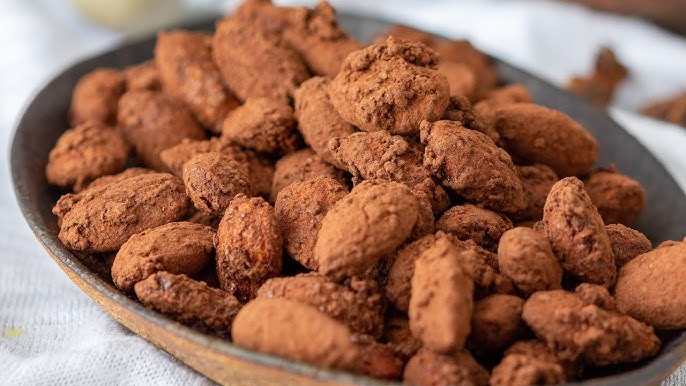Roasted Almonds Recipe: There’s something undeniably irresistible about a bowl of warm, crunchy roasted almonds. Whether you’re in the mood for a healthy snack, a crunchy salad topping, or a protein-packed post-workout treat, roasted almonds fit the bill perfectly. They’re rich in flavor, incredibly versatile, and surprisingly simple to make at home. Forget store-bought—this step-by-step guide will teach you how to roast almonds in your own kitchen like a pro. Let’s dive in and get roasting!
Why Roasted Almonds are a Must-Try Snack
Let’s be honest—snacking doesn’t have the best reputation. Most of the time, it’s linked with junk food and empty calories. But roasted almonds? They’re a total game-changer. With their nutty aroma, satisfying crunch, and endless flavor possibilities, roasted almonds are what snack dreams are made of.
What makes them even better is their simplicity. You don’t need fancy tools or a culinary degree to roast almonds at home. All it takes is a handful of quality ingredients, a bit of time, and your favorite seasonings. Plus, they’re way more affordable than buying pre-roasted, flavored almonds from the store. Roasting them yourself gives you control over everything—salt, oil, spices, even sweetness!
Perfect for movie nights, packed lunches, post-workout nibbles, or fancy cheese boards, roasted almonds are more than just a snack—they’re a lifestyle.
Health Benefits of Almonds
Beyond the irresistible flavor and crunch, almonds are nutritional powerhouses. They’re loaded with good fats, fiber, protein, and an impressive lineup of vitamins and minerals. Here’s why adding roasted almonds to your daily routine is a smart move:
- Heart Health: Almonds are rich in monounsaturated fats, the kind that supports healthy cholesterol levels and reduces heart disease risk.
- Protein Boost: With about 6g of protein per ounce, they’re excellent for muscle repair and energy.
- Packed with Nutrients: Vitamin E, magnesium, calcium, and potassium—almonds have them all.
- Blood Sugar Friendly: They have a low glycemic index and can help regulate blood sugar levels.
- Weight Management: Almonds are filling and satisfying, which means you’re less likely to over-snack on unhealthy stuff.
Roasting them doesn’t strip away these benefits—just keep the oil light and seasoning moderate, and you’re good to go.
Ingredients You’ll Need
Basic Ingredients for Classic Roasted Almonds
Here’s what you’ll need to create a batch of perfect, no-frills roasted almonds:
- Raw Almonds – 2 cups (you can scale up or down)
- Olive Oil or any neutral oil – 1 to 2 tablespoons
- Sea Salt – 1 teaspoon (adjust to taste)
This trio forms the foundation of classic roasted almonds—nutty, lightly salted, and beautifully golden.
Optional Ingredients for Flavor Variations
Want to elevate your roasted almonds? Here are some exciting additions to mix things up:
- Honey or Maple Syrup (for sweetness)
- Cinnamon, Nutmeg, or Pumpkin Spice (sweet warmth)
- Smoked Paprika, Chili Powder, or Cayenne (spicy kick)
- Garlic Powder, Onion Powder, or Rosemary (savory depth)
- Soy Sauce or Tamari (umami twist)
- Vanilla Extract (sweet aroma)
You can create anything from cinnamon-sugar almonds to spicy garlic-roasted nuts just by tweaking a few ingredients.
Where to Buy the Best Almonds
To make the best roasted almonds, start with the best raw almonds. Here’s where to look:
- Bulk Food Stores: Often cheaper and fresher, especially if they have high turnover.
- Health Food Markets: Usually offer organic and non-GMO varieties.
- Online Retailers: Great for large quantities or specialty types like Marcona almonds.
- Farmers’ Markets: Ideal for getting fresh, locally grown nuts.
Always check for freshness—look for whole, plump almonds without cracks or mold. Fresh almonds should have a mild nutty smell—not sour or musty.
Kitchen Tools and Equipment
Must-Have Kitchen Tools
No high-end gadgets are required, just a few essentials:
- Baking Sheet: A rimmed one is best to keep almonds from sliding off.
- Parchment Paper or Silicone Baking Mat: Helps with even roasting and easy cleanup.
- Mixing Bowl: For tossing almonds in oil and seasoning.
- Measuring Spoons: Precision matters—especially with salt or spices.
- Oven Mitts or Tongs: Safety first when handling a hot tray!
Recommended Alternatives
If you don’t have everything on the list, here are a few quick swaps:
- No parchment? Lightly grease your baking tray instead.
- No mixing bowl? Use a zip-lock bag to shake and coat almonds.
- No oven? You can roast them on a stovetop pan (we’ll cover this later!).
Keeping it simple is the name of the game. If you have an air fryer, you can even roast almonds in there with a slight tweak in temperature and time.
Preparation Tips Before Roasting
Choosing the Right Almonds
This might sound obvious, but not all almonds are created equal. For roasting, go for:
- Raw, Unsalted Almonds – You want to control the seasoning from scratch.
- Whole Almonds – Sliced or slivered almonds can roast unevenly and burn.
- Fresh and Plump – No shriveled or cracked ones.
Avoid pre-roasted or flavored almonds—they won’t roast well a second time and may turn bitter.
Soaking vs. Dry Roasting – What’s Better?
Some folks soak almonds before roasting to make them easier to digest. While it’s not required, here’s a quick comparison:
- Soaked Almonds: May lose crunch but easier on digestion. Need to dry thoroughly before roasting.
- Dry Roasting: Gives maximum crunch and flavor. No extra step needed.
If you choose to soak, plan ahead—soak overnight and let them dry for at least 12 hours before roasting. Otherwise, you risk a soggy batch.
Preheating the Oven and Preparing the Tray
Preheating is crucial for even roasting. Here’s what to do:
- Preheat Oven to 350°F (175°C)
- Line Baking Tray with parchment or silicone mat.
- Spread Almonds in a Single Layer for even heat exposure.
Make sure almonds aren’t stacked or crowded—this ensures even roasting and no soggy centers.
Step-by-Step Guide to Roasting Almonds
Step 1: Preheat Your Oven
Start by preheating your oven to 350°F (175°C). A properly heated oven ensures the almonds roast evenly and develop that deep, toasty flavor without burning. Line a baking tray with parchment paper or foil for easy cleanup.
Step 2: Rinse and Dry the Almonds
Place the raw almonds in a bowl and give them a quick rinse under cool water. Pat them completely dry with a clean kitchen towel or paper towel. This removes any dust or residue and helps the seasonings stick better later.
Step 3: Add Oil and Seasonings
Transfer the dried almonds to a mixing bowl. Drizzle with a small amount of olive oil or melted butter — just enough to lightly coat them. Season with salt for a classic flavor, or experiment with spices like smoked paprika, cinnamon, chili powder, or rosemary for something unique. Toss well so every almond is evenly coated.
Step 4: Spread Evenly on the Baking Tray
Arrange the almonds in a single layer on your prepared baking tray. Avoid overcrowding — giving them space ensures they roast, not steam, resulting in a crisp, even texture.
Step 5: Roast the Almonds
Place the tray in the preheated oven and roast for 10–15 minutes, depending on your desired level of crunch. Keep an eye on them — nuts can go from perfectly golden to burnt in seconds.
Step 6: Stir Halfway Through
About halfway through the roasting time, use a spatula to stir the almonds. This helps them brown evenly and prevents any from getting too dark on one side.
Step 7: Cool and Store Properly
Once the almonds are fragrant and golden brown, remove them from the oven and let them cool completely on the tray. They’ll crisp up as they cool. When fully cooled, store them in an airtight container at room temperature for up to two weeks. Enjoy them as a snack, salad topping, or crunchy addition to your favorite dishes!
Roasting Almonds on a Stovetop
Pan Roasting Technique
Don’t have an oven? No problem! You can easily roast almonds on the stovetop with a few adjustments.
Here’s how:
- Use a heavy-bottomed skillet or frying pan (non-stick or cast iron is best).
- Add 1 teaspoon of oil to the pan over medium heat.
- Pour in your raw almonds and stir to coat evenly with the oil.
- Continue to toast the almonds for 8–10 minutes, stirring constantly.
- You’ll notice them starting to brown and smell fragrant—don’t walk away!
- Once golden, remove from heat and cool on a plate lined with paper towels.
Stovetop-roasted almonds might not get the same even roast as oven-roasted ones, but they’re a solid alternative if you’re in a hurry or don’t want to heat the oven.
Tips to Avoid Burning
Burnt almonds are the worst. Here are some ways to prevent it, especially on the stovetop:
- Low and slow wins the race—don’t crank the heat too high.
- Stir constantly—this prevents hot spots and scorched nuts.
- Don’t crowd the pan—roast in batches if needed.
- Remove immediately when done—residual heat can keep cooking them even after they’re off the stove.
Roasting on the stovetop also gives you the chance to season them right in the pan. Add spices in the last minute for maximum flavor without burning.
Flavor Variations for Roasted Almonds
Sweet Roasted Almonds
Sweet roasted almonds are a crowd favorite—perfect for holiday treats, gift jars, or just a cozy snack on a cold evening. Here’s a simple recipe to make your almonds sweet and addictive:
Ingredients:
- 2 cups raw almonds
- 2 tbsp honey or maple syrup
- 1 tbsp brown sugar (optional, for extra crunch)
- 1 tsp ground cinnamon
- Pinch of sea salt
- 1 tbsp oil (coconut oil adds a hint of sweetness)
Steps:
- Mix honey or syrup with oil and cinnamon in a bowl.
- Toss almonds until evenly coated.
- Spread on parchment-lined tray and roast at 350°F (175°C) for 10–12 minutes.
- Stir halfway and watch closely to avoid burning the sugar.
- Cool completely before storing.
These almonds come out slightly sticky when warm but turn into crunchy, candy-like bites once cooled. You can even toss them in powdered sugar afterward for a frosted look.
Savory and Spicy Roasted Almonds
If you like bold flavors, go for savory or spicy roasted almonds. These are great for game nights, charcuterie boards, or cocktail parties.
Popular Savory Combos:
- Garlic & Herb: Olive oil, garlic powder, rosemary, thyme
- Spicy Kick: Olive oil, cayenne, chili powder, smoked paprika
- Mediterranean: Olive oil, za’atar spice, lemon zest
Basic Method:
- Mix seasonings with oil.
- Coat almonds thoroughly.
- Roast and stir halfway.
- Cool and enjoy!
Savory almonds pair great with cheese boards, wine, or even crumbled over salads for extra flavor.
Herbed Almonds for a Gourmet Touch
Want to make gourmet roasted almonds that impress guests? Try herb-infused versions. These are elevated, sophisticated, and pair beautifully with drinks like red wine or craft beer.
Try this combo:
- Olive oil
- Fresh or dried rosemary
- Thyme
- Crushed black pepper
- Sea salt
- A touch of lemon zest
Instructions:
- Heat oil with herbs briefly on low heat (optional but boosts flavor).
- Toss with almonds and roast as usual.
- Let cool and serve in fancy bowls—it’s that simple!
These make great gifts too. Just pack them in a glass jar with a rustic ribbon and you’ve got yourself a homemade gourmet snack.
Storage Tips for Roasted Almonds
How to Keep Almonds Fresh Longer
Roasted almonds can stay crisp and flavorful for weeks—if stored properly. Here’s how to make them last:
- Cool them completely before storing. Warm almonds create moisture, which kills the crunch.
- Use airtight containers—glass jars, sealed plastic tubs, or zip-lock bags all work.
- Store in a cool, dark place like a pantry or cupboard. Avoid areas near the stove or oven.
If you made a large batch or live in a humid area, keep them in the fridge. They’ll stay fresh for up to 2 months this way.
Want to stretch that even further? Freeze them! Roasted almonds freeze well and can be stored for up to 6 months. Just thaw for a few minutes before eating.
Shelf Life and Signs of Spoilage
Here’s a quick guide:
- Room temp (sealed): 2–3 weeks
- Refrigerated: 2 months
- Frozen: 6 months
Check for spoilage by smell and taste. Rancid almonds will have a sour, bitter, or “paint-like” smell. If they’ve lost their crunch or taste stale, it’s time to toss them out.
Always label your jars or containers with the roast date. It’s easy to forget when you made them, especially if you’re roasting often (which you might start doing after trying this recipe!).
Nutritional Value of Roasted Almonds
Calorie Count and Macronutrients
Almonds are dense in nutrients and calories. Here’s a breakdown for a 1 oz (28g) serving of plain roasted almonds:
| Nutrient | Amount |
|---|---|
| Calories | 165 |
| Protein | 6g |
| Fat | 14g |
| Carbohydrates | 6g |
| Fiber | 3.5g |
| Sugar | 1g (natural) |
| Vitamin E | 7.3mg (37% DV) |
| Magnesium | 76mg (19% DV) |
They’re high in healthy fats, primarily monounsaturated fat, which is excellent for heart health. They’re also a great plant-based protein source.
Comparison: Raw vs. Roasted Almonds
There’s a common myth that roasting destroys nutrients. The truth? While some sensitive vitamins (like vitamin E) may decrease slightly, the difference is minimal—and you’re still getting a powerful nutritional punch.
Key differences:
| Nutrient | Raw Almonds | Roasted Almonds |
|---|---|---|
| Calories | 160 | 165 |
| Protein | 6g | 6g |
| Vitamin E | Slightly higher | Slightly lower |
| Antioxidants | Slightly higher | Moderate |
As long as you’re not deep-frying them or coating them in sugar every time, roasted almonds remain a healthy, protein-packed snack.
Serving Suggestions
Roasted Almonds as a Snack
You don’t need a reason to eat roasted almonds—they’re amazing all by themselves. Keep a jar at your desk, in your car, or your gym bag for when hunger strikes.
Snack ideas:
- Mix with dried cranberries and dark chocolate chips for a quick trail mix.
- Combine with pretzels, cashews, and popcorn for a savory snack mix.
- Pack a small handful in your lunchbox for a protein-rich pick-me-up.
They’re filling, portable, and easy to portion—making them ideal for healthy snacking.
Using Roasted Almonds in Recipes
Don’t just snack on them—cook with them! Roasted almonds can elevate lots of dishes.
Try these ideas:
- Toss into salads for crunch and flavor.
- Blend into almond butter for a deeper, roasted taste.
- Crush and coat chicken or fish for a nutty crust.
- Add to baked goods like muffins or granola bars.
- Top smoothie bowls or yogurt with chopped almonds for texture.
The possibilities are endless once you start experimenting. Just be warned—once you get the hang of roasting almonds, you might never go back to store-bought again.
Common Mistakes to Avoid
Overcooking or Burning
This is the number one mistake people make when roasting almonds. These nuts go from golden brown to bitter charcoal in a matter of minutes. Here’s how to avoid ruining a good batch:
- Always set a timer. Even 2 minutes too long can be the difference between delicious and destroyed.
- Watch closely after the 10-minute mark. The last few minutes are the most crucial.
- Know your oven. If it runs hot, lower the temp by 10–15 degrees.
- Check the color. You want a light golden brown, not dark brown or black.
If your almonds taste bitter or have a burnt aftertaste, you’ve overcooked them. Unfortunately, there’s no fixing that—so it’s best to start fresh.
Skipping the Stir Step
Many people forget to stir or shake the almonds midway through roasting. But this step is crucial. Without it, the bottoms may brown faster than the tops, leaving you with unevenly roasted nuts.
Tips to stir correctly:
- Use a spatula to turn the almonds or give the tray a firm shake.
- Do it gently—you don’t want to knock the seasoning off.
- Repeat if needed—especially for larger batches or sweet-coated almonds.
Taking just a minute to stir ensures every almond is roasted evenly, giving you the best flavor and texture possible.
FAQs about Roasted Almonds Recipe
1. Can I use flavored oils like garlic or truffle for roasting almonds?
Absolutely! Flavored oils can add a gourmet touch. Just be cautious with the quantity as strong flavors like truffle can overpower the almonds. Start with a small amount and taste test before roasting a big batch.
2. Can roasted almonds be re-roasted if they lose their crunch?
Technically, yes. You can pop them back in the oven at 300°F (150°C) for 5–7 minutes. This can revive the crunch, especially if they’ve absorbed moisture. Just be careful not to burn them the second time.
3. Are roasted almonds safe for kids?
Definitely! Just ensure they’re not too hard for younger kids and avoid spicy or overly salty versions. Also, always supervise toddlers while eating nuts to prevent choking.
4. How do I make roasted almonds more digestible?
Soak almonds overnight, then dry them completely before roasting. This removes phytic acid and activates enzymes that can aid digestion. Just remember soaked almonds take longer to crisp in the oven.
5. Can I roast almonds in an air fryer?
Yes! Set your air fryer to 325°F (160°C) and roast for 8–10 minutes, shaking the basket halfway through. It’s quicker and still delivers a great crunch—just don’t overcrowd the basket.
Conclusion
Roasted almonds are more than just a healthy snack—they’re a flavor-packed, crunchy delight that you can customize in countless ways. From savory herb blends to sweet cinnamon crunch, the combinations are endless. The best part? You don’t need any fancy equipment or culinary skills—just an oven, some raw almonds, and a dash of creativity.
Not only are they cheaper and healthier than store-bought snacks, but they also make impressive gifts and versatile recipe additions. Once you master the roasting basics, you’ll find yourself making batch after batch—and probably never buying packaged nuts again.
So go ahead—grab a bag of raw almonds and try roasting them at home. One taste, and you’ll wonder why you didn’t start sooner!



